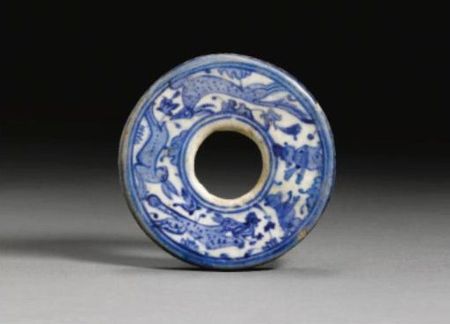A blue and white Iznik pottery disc, Turkey, circa 1520
A blue and white Iznik pottery disc, Turkey, circa 1520. Photo Sotheby"s
of circular form with a central broad aperture, decorated on both sides in underglaze cobalt blue and touches of turquoise with a continuous frieze of animals, including hares, foxes, dogs, chickens, monkeys and harpies, the outer edge with a band of interweaving strapwork; 10cm. diameter. Lot 110. Estimate 20,000-30,000 GBP
EXHIBITED: Couleurs d'Orient, Brussels, 2010
Turkophilia, Paris, 2011
LITTERATURE: Brussels 2010, p.26
Paris 2011, p.39
NOTE: This extremely rare form is paralleled only in fragmentary sherds excavated at Iznik (Atasoy and Raby 1989, p.55, no.49). The decoration of these fragments is also in a manner suggesting a date early in the sixteenth century or earlier, largely in blue and white. The decoration of the present example is deftly painted using varied tones of cobalt blue with small touches of turquoise to create an extremely enlivened design of fabulous and coursing beasts. This decorative repertoire calls to mind the designs found on Balkan silverwork. The influence of this on Iznik occurs in the later sixteenth century but this disc suggests earlier precedents for that later tradition and a probably direct familiarity with the silver amongst some of the Iznik decorators at this time. The touches of turquoise, following traditional dating rationales, puts the disc into the 1520s. The painterly quality of the depictions of the beasts suggests that it is no later than this.
The series of roundels formed by interweaving strapwork which decorated the edge of the disc are found on a series of Iznik mosque lamps, all of which are in the Cinili Kosk, Istanbul (Atasoy and Raby 1989, p.159, nos.293-6). The function of the object has not yet been determined. It resembles a weight but neither the material nor the decoration makes this likely. It make have acted as a saucer for a cup. Numerous forms of cups seems to have been in use amongst which are cups with saucers (ibid., p.47). Since silver cups (tas) from the Balkans were likely to have been present in Constantinople from its capture by the Ottomans it is possible that such a vessel might have inspired the decoration of this disc and been placed in the aperture at its centre.
Sotheby's. An Eye For Opulence- Art of the Ottoman Empire. Londres | 24 avr. 2012, 02:30 PM www.sothebys.com

/https%3A%2F%2Fprofilepics.canalblog.com%2Fprofilepics%2F1%2F0%2F100183.jpg)
/https%3A%2F%2Fstorage.canalblog.com%2F03%2F02%2F119589%2F96711876_o.jpg)
/https%3A%2F%2Fstorage.canalblog.com%2F11%2F31%2F119589%2F94773502_o.jpg)
/https%3A%2F%2Fstorage.canalblog.com%2F20%2F83%2F119589%2F94772815_o.jpg)
/https%3A%2F%2Fstorage.canalblog.com%2F26%2F72%2F119589%2F75604929_o.jpg)
/https%3A%2F%2Fstorage.canalblog.com%2F59%2F60%2F119589%2F26458628_o.jpg)



/image%2F1371349%2F20240414%2Fob_83ee65_2024-nyr-22642-0954-000-a-blue-and-whi.jpg)
/image%2F1371349%2F20240414%2Fob_15808c_2024-nyr-22642-0953-000-a-blue-and-whi.jpg)
/image%2F1371349%2F20240414%2Fob_e54295_2024-nyr-22642-0952-000-a-rare-blue-an.jpg)
/image%2F1371349%2F20240414%2Fob_b161a4_2024-nyr-22642-0951-000-a-blue-and-whi.jpg)